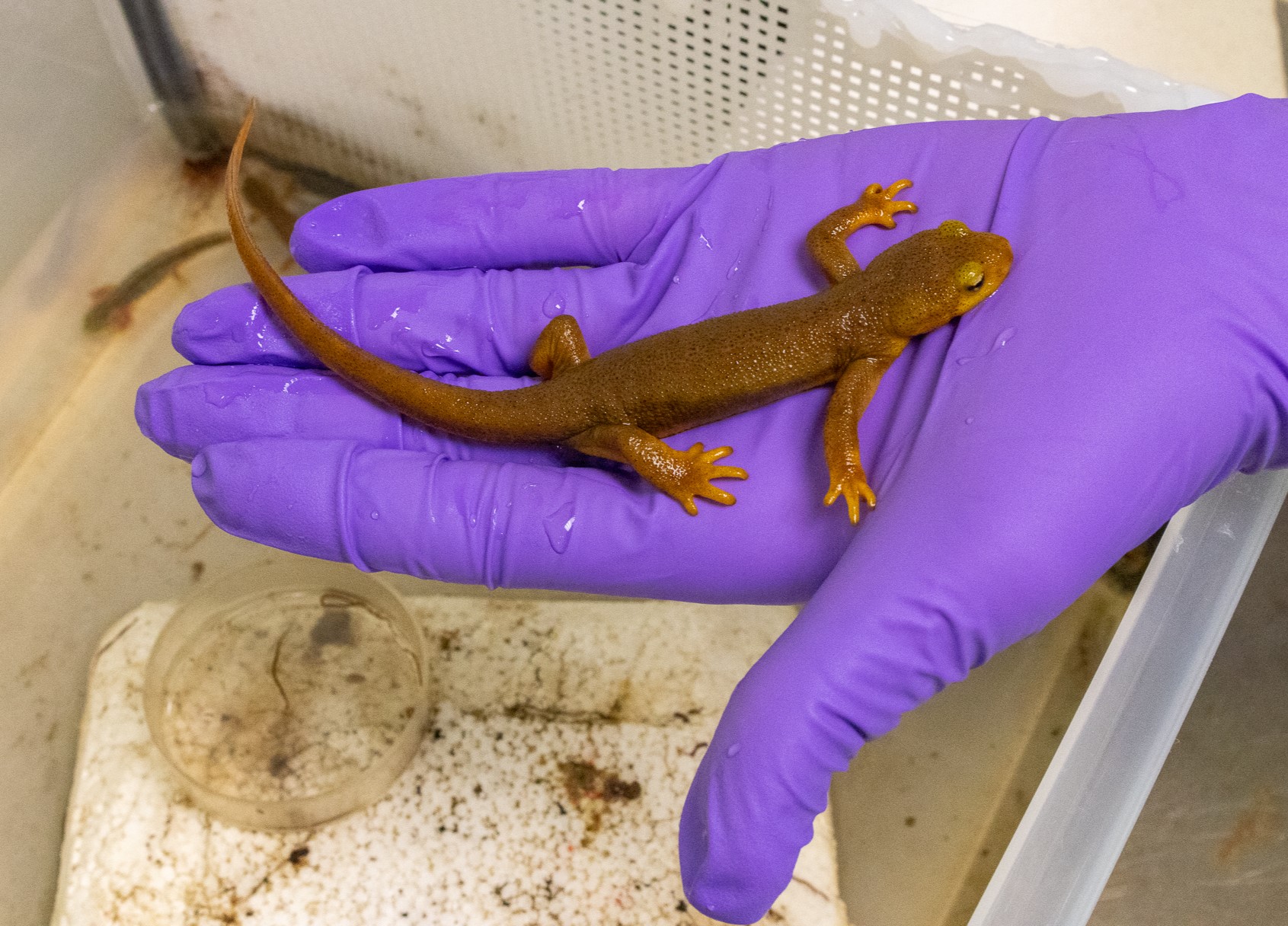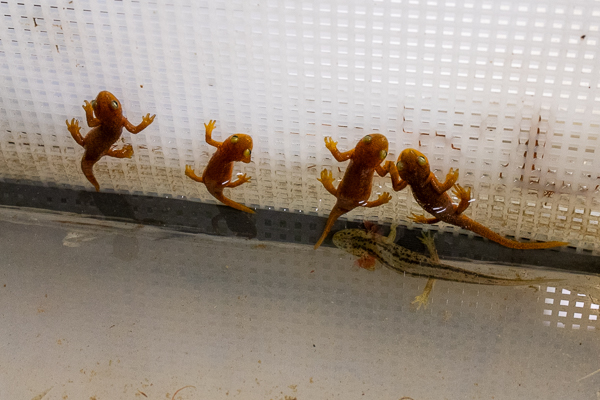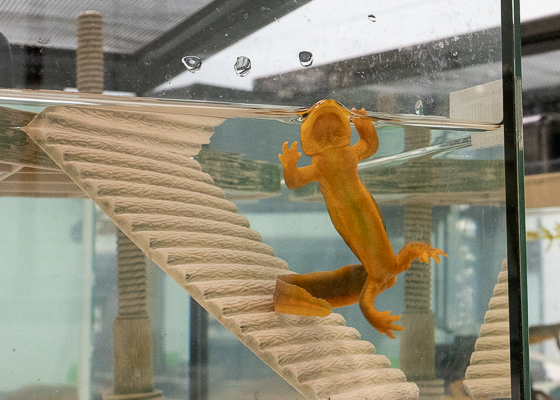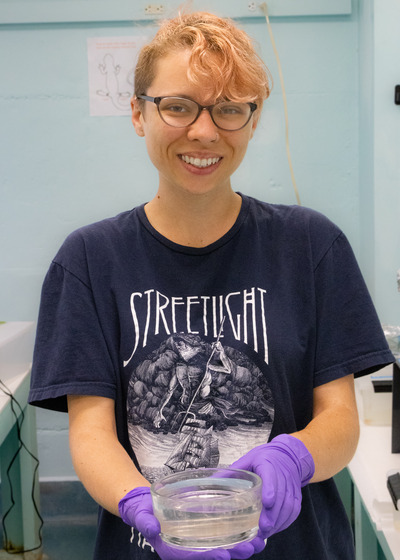The genetic blueprint of a neurotoxin

A team of Michigan State University researchers is investigating a long-standing biological mystery: how certain bacteria produce tetrodotoxin, or TTX — a powerful neurotoxin best known as the potentially deadly compound in fugu, the Japanese pufferfish.
Supported by a grant from the National Institutes of Health, this foundational research could lead to breakthroughs in neurobiology, pain management and food safety.
Since its initial discovery in 1909, TTX has been found in a wide variety of marine and terrestrial animals, including octopuses, newts and even certain types of crabs. These animals do not produce TTX themselves but rather acquire it from symbiotic bacteria or through their diet.
Now, MSU researchers Heather Eisthen, Aretha Fiebig, and Elizabeth Heath-Heckman are combining their expertise in neurobiology, microbiology, and host-microbe interactions, along with analytical chemist Tian (Autumn) Qiu to investigate how bacteria create TTX.

“We bring together a lot of expertise, which I think is a really great way to make headway” said Fiebig, associate professor in the department of microbiology, genetics, & immunology.
Why it matters
The implications of this study are significant across multiple areas of science and medicine.
TTX is a widely used tool in neurobiology research, but producing it currently requires extracting it from animals. If scientists can understand how bacteria make it, they could produce it more sustainably in the lab. TTX is also being explored as a pain reliever for chronic conditions such as fibromyalgia and arthritis. By understanding which genes produce the neurotoxin, researchers could potentially modify them to develop safer, more targeted versions.
The work also has implications for food safety. Scientists hope to develop tools to detect the presence of TTX-producing bacteria in food samples. This breakthrough could help prevent foodborne illnesses, particularly those linked to contaminated shellfish, which continue to cause fatalities each year.
In addition to these direct impacts, the work is also an important piece of foundational research. Expanding our knowledge of bacterial metabolic capabilities and biosynthetic genes could reveal new roles for genes we have already identified.

“There’s almost certainly novel chemistry involved in this thing,” said Eisthen, professor of integrative biology and principal investigator on the study. “People have known for decades what it looks like, and they can’t figure out how it’s made. If we could find even one gene that was involved in TTX production, that would be a breakthrough, but also, I think that could potentially rapidly lead to figuring out a whole lot more.”
A stubborn molecule
TTX’s lethal effects stem from its ability to interrupt the transmission of signals from nerves to muscles, specifically interfering with the way neurons and muscles get excited by sodium ions. But what makes TTX especially alarming is how tightly it binds to its target. In lab settings, it clings to sodium channels so stubbornly that even after extensive washing, it refuses to budge. This kind of binding strength is rare among toxins, and Eisthen hypothesizes that it likely comes down to interactions at the atomic level.
TTX is also incredibly resilient — resistant to heat, acid and other conditions that would normally break down organic compounds. This durability is part of what makes it so dangerous when it ends up in food.
A unique resource
Eisthen has dedicated decades to researching salamanders, focusing primarily on olfaction and chemical communication. About 14 years ago, she expanded her work to include a type of salamander known as rough-skinned newts and discovered that they harbor TTX-producing bacteria on their skin.

These newts live in easy-to-reach freshwater habitats along the west coast of North America and aren’t endangered or threatened, making it simple to collect them and grow TTX-producing bacterial strains.

Over the years, Eisthen’s lab has amassed an unparalleled resource: a collection of 20 strains that generate TTX across seven different genera along with 800-900 additional specimens that haven’t yet been tested to see if they are TTX synthesizers. This extensive collection is the only one like it in the world, and it’s invaluable for researchers aiming to identify the genes responsible for toxin creation.

This project got its start thanks to Sam Westcott, a doctoral student in Eisthen’s lab. Although she was originally interested in studying the mechanisms of symbiosis between the newts and the bacteria, in January of 2020, Westcott foresaw the impact that COVID might have on her research and decided to change course.
She rapidly cultured a collection of TTX-producing bacteria, extracted the DNA, and sent it for sequencing just a couple of days before MSU closed. The genomic data returned shortly after the shutdown, and Westcott began teaching herself bioinformatics at home.
“So that’s how the project started,” said Eisthen, “as a clever adaptation of the pandemic.”
A three-pronged approach
The team has developed a three-part strategy to uncover the genetic blueprint behind TTX.
First, by comparing the genomes of related bacteria that do or don’t generate the toxin, they hope to pinpoint specific genes that are present in toxin-producing bacteria but missing from the non-producers.
Next, they are exploring a hypothesis that bacteria lose their ability to make TTX after being cultured in the lab for extended periods.
This portion of the project involves continuously transferring bacterial samples into fresh growth media over extended periods, a common practice in microbiology. By tracking toxin levels and analyzing genetics changes over time, they aim to understand how culturing affects toxin production.
The third strategy focuses on creating a large collection of bacterial mutants using transposons, which randomly disrupt genes.
“You take a population of bacteria, you add the transposon, and in each new strain, the transposon hops into a different location and disrupts a different gene,” said Fiebig. “So, you have this whole collection of tens of thousands of mutants where a different gene is disrupted in each one.”
Once the mutants are created, the researchers will analyze each sample to determine if it is still capable of producing TTX.
The challenge of detection

“One of the reasons we don’t know that much about the molecular parts of TTX is that it’s actually not trivial to detect it,” said Heath-Heckman, assistant professor in the department of microbiology, genetics, & immunology. “The major way that people can detect unequivocally that you have TTX in a sample is by mass spec. It’s very laborious, it’s not high throughput.”
Mass spectrometry is not only laborious, it’s also expensive in terms of both time and money. So, the team is working with Qiu, an assistant professor in the department of chemistry, to develop a high-throughput assay, a faster, more efficient way to screen samples, that would be especially useful for testing Eisthen’s extensive collection of bacterial strains.
Looking forward
While the biological origins of tetrodotoxin remain elusive, the team’s cross-disciplinary approach — combining genomics, microbiology and analytical chemistry — offers a promising path forward. Their work could not only solve the mystery of TTX production but also open new doors in science, medicine and public health.
- Categories: